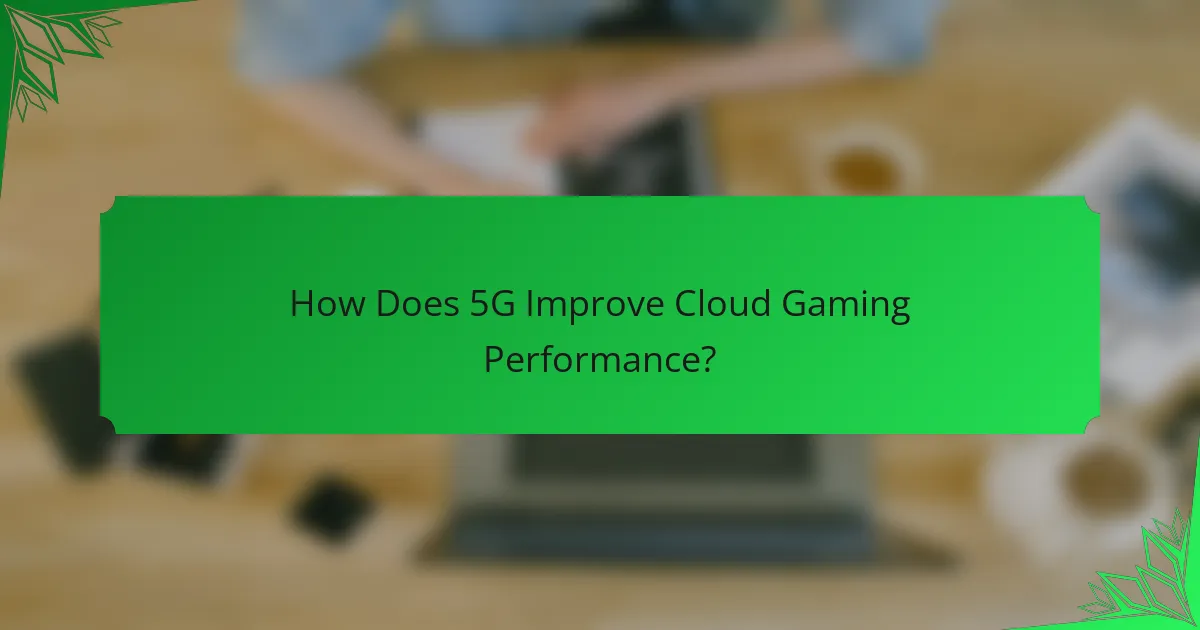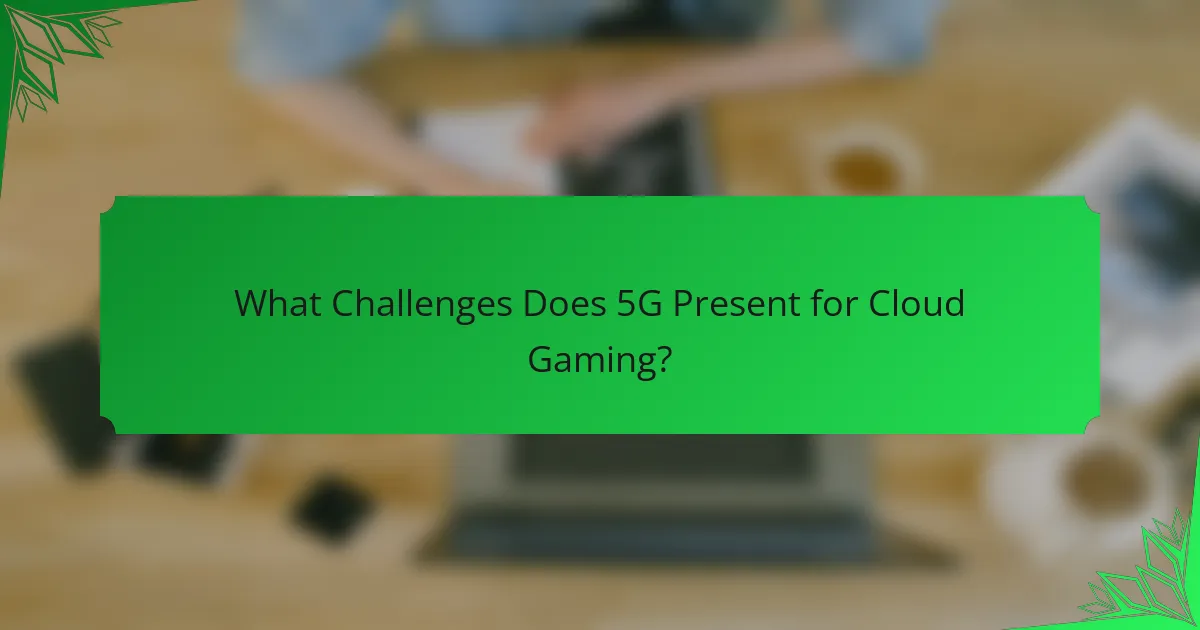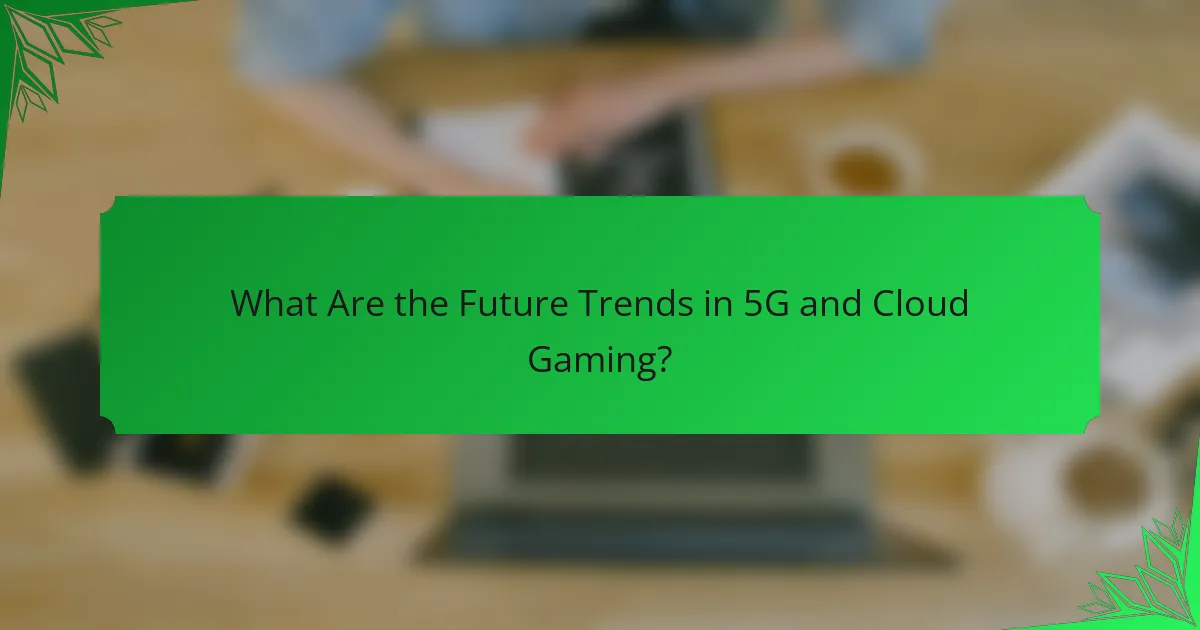The advent of 5G technology is revolutionizing cloud gaming by providing lower latency, higher bandwidth, and enhanced stability. These improvements lead to smoother gameplay and quicker response times, making cloud gaming a more enjoyable and viable option for players. However, challenges such as infrastructure and device compatibility must be addressed to fully harness these benefits.

How Does 5G Improve Cloud Gaming Performance?
5G enhances cloud gaming performance primarily through lower latency, higher bandwidth, and improved stability. These advancements facilitate smoother gameplay, quicker response times, and a more reliable gaming experience, making cloud gaming more viable and enjoyable for users.
Lower latency
Lower latency is crucial for cloud gaming, as it reduces the delay between a player’s action and the game’s response. With 5G, latency can drop to as low as 10 milliseconds, compared to 30-50 milliseconds typical in 4G networks. This significant reduction allows for real-time interactions, which is essential for fast-paced games.
To maximize the benefits of low latency, players should ensure they are connected to a 5G network and use devices that support the latest technology. Avoiding congested areas and using dedicated gaming modes on routers can further enhance performance.
Higher bandwidth
Higher bandwidth provided by 5G networks enables faster data transfer rates, which is vital for streaming high-quality graphics in cloud gaming. Bandwidth can reach up to 10 Gbps in optimal conditions, allowing for seamless streaming of 4K content without buffering. This is a considerable improvement over the lower bandwidths of previous generations.
For gamers, this means they can enjoy richer visuals and more detailed environments without sacrificing performance. To take full advantage of higher bandwidth, players should consider using wired connections when possible and ensure their internet plans support high-speed access.
Improved stability
Improved stability in 5G networks translates to a more consistent gaming experience with fewer interruptions. Unlike 4G, which can suffer from fluctuations in signal strength, 5G networks are designed to maintain stable connections even in crowded areas. This stability is essential for multiplayer gaming, where disconnections can lead to frustrating experiences.
To ensure optimal stability, gamers should choose locations with strong 5G coverage and minimize interference from physical obstructions. Regularly updating devices and software can also help maintain a stable connection, enhancing the overall gaming experience.

What Are the Key Benefits of 5G for Gamers?
5G technology significantly enhances gaming experiences by offering faster speeds, lower latency, and improved connectivity. These benefits translate into better graphics, smoother multiplayer interactions, and easier access to cloud gaming platforms.
Enhanced graphics quality
With 5G, gamers can enjoy enhanced graphics quality due to higher data transfer rates. This allows for richer textures, more detailed environments, and overall improved visual fidelity in games. For instance, games that require high-resolution assets can stream them more effectively, resulting in a more immersive experience.
Moreover, the low latency associated with 5G means that graphical updates occur almost instantaneously, reducing lag and providing a smoother visual experience. This is particularly beneficial in fast-paced games where every millisecond counts.
Seamless multiplayer experiences
5G technology facilitates seamless multiplayer experiences by significantly reducing latency, often to low tens of milliseconds. This reduction allows players to interact in real-time without noticeable delays, which is crucial for competitive gaming.
Additionally, the increased bandwidth of 5G supports more simultaneous connections, enabling larger multiplayer sessions without performance degradation. Gamers can enjoy smoother gameplay even in crowded online environments, enhancing overall enjoyment.
Access to cloud gaming platforms
5G improves access to cloud gaming platforms by providing the necessary speed and stability for streaming games directly to devices. This means gamers can play high-quality titles without the need for powerful hardware, as processing occurs in the cloud.
As a result, players can enjoy a wider variety of games on various devices, including smartphones and tablets, without compromising on performance. This flexibility allows for gaming on-the-go, making it easier to engage with friends and gaming communities anytime, anywhere.

What Challenges Does 5G Present for Cloud Gaming?
5G technology introduces several challenges for cloud gaming, primarily related to infrastructure, device compatibility, and implementation costs. These factors can significantly affect the overall gaming experience, including latency, accessibility, and affordability.
Infrastructure limitations
Despite its promise, 5G infrastructure is still being developed in many regions, leading to inconsistent coverage. Areas with limited or no 5G access can experience high latency and reduced performance, making cloud gaming difficult or impossible.
Moreover, the transition from 4G to 5G requires significant upgrades to existing networks, which can take time and investment. Users in rural or less populated areas may find themselves at a disadvantage due to slower internet speeds and unreliable connections.
Device compatibility issues
Not all devices support 5G, which can limit the accessibility of cloud gaming services. Many older smartphones, tablets, and laptops may not be equipped to take advantage of the faster speeds and lower latency that 5G offers.
Additionally, even if a device is 5G-compatible, it may require specific software updates or configurations to optimize cloud gaming performance. Users should verify their device’s capabilities and ensure they are using the latest software to avoid potential issues.
Cost of implementation
The cost of implementing 5G technology can be a barrier for both service providers and consumers. Network operators must invest heavily in infrastructure, which can lead to higher service fees for users.
Consumers may also face increased costs for 5G-compatible devices, which can be significantly more expensive than their 4G counterparts. As a result, the overall expense of accessing high-quality cloud gaming may deter some users, particularly in regions where 5G is still being rolled out.

How Can Gamers Optimize Their Experience with 5G?
Gamers can enhance their cloud gaming experience with 5G by selecting appropriate devices, utilizing networks efficiently, and adjusting game settings. These strategies help minimize latency and improve overall performance, making gameplay smoother and more enjoyable.
Choosing the right devices
Selecting devices that support 5G is crucial for optimizing gaming performance. Look for smartphones, tablets, or laptops that have the latest 5G capabilities, as older models may not fully leverage the speed and low latency offered by 5G networks.
Additionally, ensure that your device has a strong processor and sufficient RAM to handle cloud gaming demands. Devices with high refresh rates and low input lag can significantly enhance your gaming experience.
Utilizing 5G networks effectively
To make the most of 5G networks, connect to the strongest available signal. Use a 5G plan that offers high data speeds and low latency, as these factors directly impact gaming performance.
Consider using a mobile hotspot if your home Wi-Fi is unreliable. This can provide a more stable connection, especially in areas with strong 5G coverage. Always check your data usage, as cloud gaming can consume significant amounts of data.
Adjusting game settings
Adjusting in-game settings can help optimize performance on 5G. Lowering graphics settings can reduce the demand on your device and improve responsiveness, especially if you experience lag.
Many games offer options to adjust resolution and frame rates; experimenting with these settings can lead to a better balance between visual quality and performance. Additionally, enabling features like adaptive bitrate streaming can help maintain a smooth experience even with fluctuating network conditions.

What Are the Future Trends in 5G and Cloud Gaming?
The future of 5G and cloud gaming is poised for significant advancements, primarily driven by faster speeds, lower latency, and increased connectivity. These improvements will enhance user experiences, enabling more immersive and responsive gaming environments.
Increased adoption of 5G
The widespread rollout of 5G networks is expected to accelerate cloud gaming adoption. With download speeds potentially exceeding 1 Gbps and latency dropping to low tens of milliseconds, gamers can expect smoother gameplay and quicker response times. This shift will likely encourage more players to transition from traditional gaming setups to cloud-based platforms.
As mobile devices become more capable, the integration of 5G will allow gamers to enjoy high-quality titles on the go. This means that games previously limited to consoles or PCs can now be accessed from smartphones and tablets, broadening the gaming audience.
Emergence of new gaming technologies
New gaming technologies, such as advanced graphics engines and AI-driven game design, will benefit from the capabilities of 5G. These innovations can deliver richer graphics and more complex game mechanics, enhancing overall player engagement. As 5G becomes more prevalent, developers will likely create games that fully utilize its potential.
Additionally, the rise of cross-platform gaming will be facilitated by 5G, allowing players on different devices to compete seamlessly. This trend will foster a more inclusive gaming community and encourage developers to create games that appeal to a wider audience.
Potential for VR and AR integration
The integration of virtual reality (VR) and augmented reality (AR) into cloud gaming is another promising trend fueled by 5G. With its high bandwidth and low latency, 5G can support the data-intensive requirements of VR and AR applications, offering immersive experiences that were previously unattainable.
For instance, players could engage in real-time multiplayer VR games without the lag that often disrupts gameplay. This capability will not only enhance user experience but also open new avenues for game design, allowing for more interactive and dynamic environments.

How Will 5G Shape the Future of Gaming in the US?
5G technology is set to significantly enhance gaming experiences in the US by providing faster speeds, lower latency, and improved connectivity. This will facilitate seamless cloud gaming, enabling players to access high-quality games without the need for powerful hardware.
Expansion of gaming communities
The rollout of 5G is likely to foster the growth of gaming communities across the US by enabling more players to connect with each other effortlessly. Enhanced mobile connectivity allows gamers to join multiplayer sessions or streaming platforms without lag, encouraging collaboration and competition.
As communities grow, developers may create more localized events and tournaments, further engaging players. This can lead to increased participation in eSports and community-driven gaming initiatives.
Growth of cloud gaming services
With 5G’s high-speed internet capabilities, cloud gaming services are expected to expand rapidly in the US. Players will be able to stream games directly to their devices without the need for downloads or extensive installations, making gaming more accessible.
Major platforms like Google Stadia and NVIDIA GeForce Now may see increased user bases as 5G reduces latency and buffering, enhancing overall user experience. This shift could lead to a more competitive landscape among service providers, benefiting consumers with better options.
Impact on game development
5G technology will influence game development by allowing creators to design more complex and immersive experiences. Developers can leverage cloud computing to create richer graphics and larger game worlds that can be streamed in real-time, pushing the boundaries of what is possible in gaming.
Additionally, the need for optimization for mobile devices will drive innovation in game design, as developers must ensure that their games perform well across various platforms. This could lead to a new wave of creativity and experimentation in the gaming industry.
